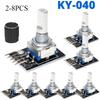Model Number : sensor
Dissipation Power : standard
Supply Voltage : standard
Application : Computer
Type : Voltage Regulator
Origin : China
Condition : New
Operating Temperature : standard
Product features:
1. Using high-quality materials with guaranteed quality
2. Exquisite product appearance
3. The product is simple and convenient to use
4. Rotation can be used to count the number of output pulses during the forward and reverse rotation processes. Unlike a potentiometer, rotation counting has no limit
5. In conjunction with the buttons on the rotary encoder, it can be reset to the initial state, which starts counting from 0
Product parameters:
Working voltage: 5V
Number of pulses per cycle: 20
Specification: threaded
The rotary encoder can count the number of pulses output during the forward and reverse rotation processes through rotation. Unlike a potentiometer, the rotation count has no limit, and with the help of buttons on the rotary encoder, it can be reset to its initial state, counting from 0
Working principle:
An incremental encoder is a rotary sensor that converts rotational displacement into a series of digital pulse signals. These pulses are used to control angular displacement. The conversion of angular displacement in the Eltra encoder adopts the principle of photoelectric scanning. The reading system is based on the rotation of a radial indexing disk (code disk) composed of alternating transparent and opaque windows, while being vertically illuminated by an infrared light source, which projects the image of the code disk onto the surface of the receiver. The receiver is covered with a layer of diffraction grating, which has the same window width as the code disk. The job of the receiver is to sense the changes caused by the rotation of the optical disc, and then convert the light changes into corresponding electrical changes. To raise the low-level signal to a higher level and generate square pulses without any interference, electronic circuits must be used for processing. The reading system usually adopts a differential method, which compares two different signals with the same waveform but a phase difference of 180 °, in order to improve the quality and stability of the output signal. The reading is formed based on the difference between the two signals, thereby eliminating interference.
Shipping list:
Module X1
The line layout is compact and regular, with good electrical insulation and mechanical stability, and can maintain stable performance under different temperature and humidity environments to ensure accuracy and reliability.
In circuit design, carefully planned lines are like precision transportation networks, and lines of different widths and spacings undertake different currents and signals transmission tasks respectively. The key signal lines are impedance matching processing, which greatly reduces signal reflection and attenuation and ensures the stable transmission of high-frequency signals.
All kinds of electronic components are soldered on the circuit board, and the solder joints are full, round, and firm and reliable. Core components like chips are perfectly connected to the circuit board through fine packaging processes to achieve high-speed data processing and interaction.
This circuit board has a wide range of responses in many fields. Whether in the industrial control field that requires extremely high stability or consumer electronics field that pursues extreme performance, it can provide solid guarantees for the stable operation of the equipment with its excellent design and reliable performance, and help various electronic devices play a powerful role.
























